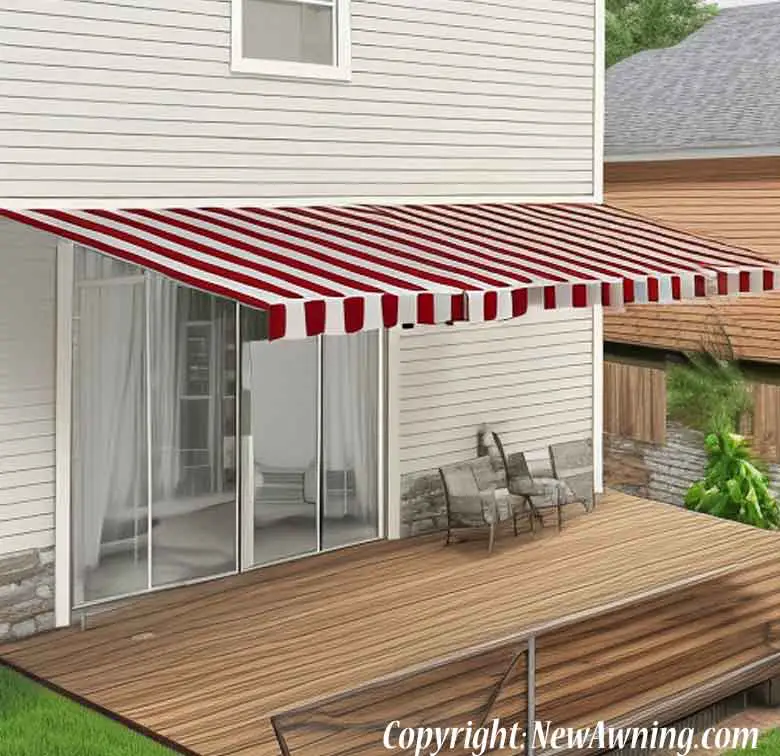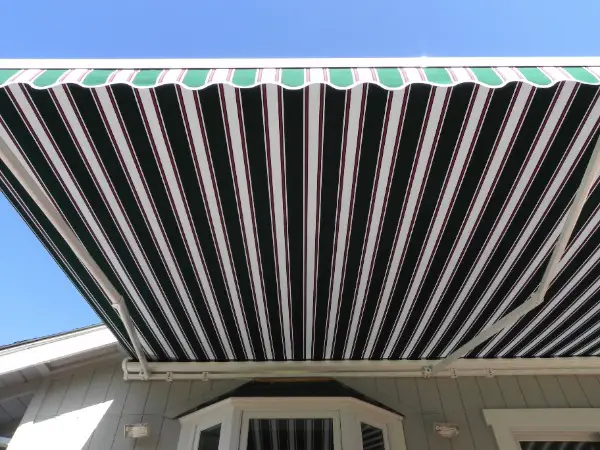
The most important aspect of learning the
styles of awning valances is to understand that each manufacturer may use slightly different terminology. We will use what we consider the industry standard names that are used by most companies; however, we will also call out the options that are commonly called by a different name or when a term is ambiguous.
This is the most common style of valances. This is merely a solid block of fabric along the side. There are neither patterns folded nor cut in the edge. This design is popular because it is often slightly less expensive than other styles because it requires less time and material. Additionally, the edge can be easily reinforced by folding the end over and using heavy stitching to create an incredibly strong border. The “straight” style has a consistent meaning with all companies so consumers will know exactly what they are getting when they purchase this option.

This option is the original design used for awnings. It begins as a straight and then rounded triangles are cut from the fabric at specified intervals. This creates an interesting pattern for the eye as the edge is an extended straight line that is periodically broken up with the small cutouts. While this term is rather universal, there are some companies that will use the term to “classic” to refer to the straight so it’s important to either see images or get the precise definition before ordering.
The is very similar to the classic pattern listed above. The primary difference is that instead of the rounded rectangle, this has a semi-circle. The pattern is a straight line for a 6′ to 12′ followed by a semi-circle cutout. While this design is universal, the details can vary greatly between individual companies. We highly recommend getting the exact specifications in terms of length of the edges as well as the size of the shapes that have been removed.
This pattern is similar to the two mentioned previously. It features extended straight stretches of material and then a small slit. This is the final valance style that has the long patches of material that is broken up by a geometrical pattern. This is a universal term used by all creators; however, we have found that a lot of businesses don’t offer this option.
This style begins as a straight edge and then large rectangular blocks are removed. The pattern is a section of regular length followed by an equal length of a cutout. This style is frequently used in Greek architecture and universal among every company we surveyed. This style is also popular for areas that have significant wind. The pattern in valance can catch the airflow causing the entire awning to sway. The movement can result in more people noticing the awning or building
The trim of this valance is a smooth rounded curve. This is low amplitude sin curve, and it is one of our favorite patterns. It can be reinforced by taking the second piece of fabric and stitching it. The serpentine pattern will never be used to describe a different pattern; however, this border will be called a “low wave” by some awning manufacturers.

The edging on this style is continuously rounded. The pattern is made of adjacent medium sized circles so that about 33% are below the normal stopping point. This creates a unique shape that is quite distinctive. This is one of the most popular of the rounded awning models.
This is truly a personal decision based on your style and the aesthetic that you are going for. We have created a Pinterest board dedicated to illustrating the various types and how they look in photos. If you are on the fence, we recommend checking out our photo board there. Additionally, if there’s a style that you are considering that you don’t see listed here, we’d love to hear from you. Just contact us with the name and possibly a link to the specific product. A lot of time the same classic designs are used and then branded with a unique moniker by the manufacturer in order to market their product under that specific trade name. We have purposefully avoided using these type of trade names when describing styles as we do not wish to choose one company over another.











